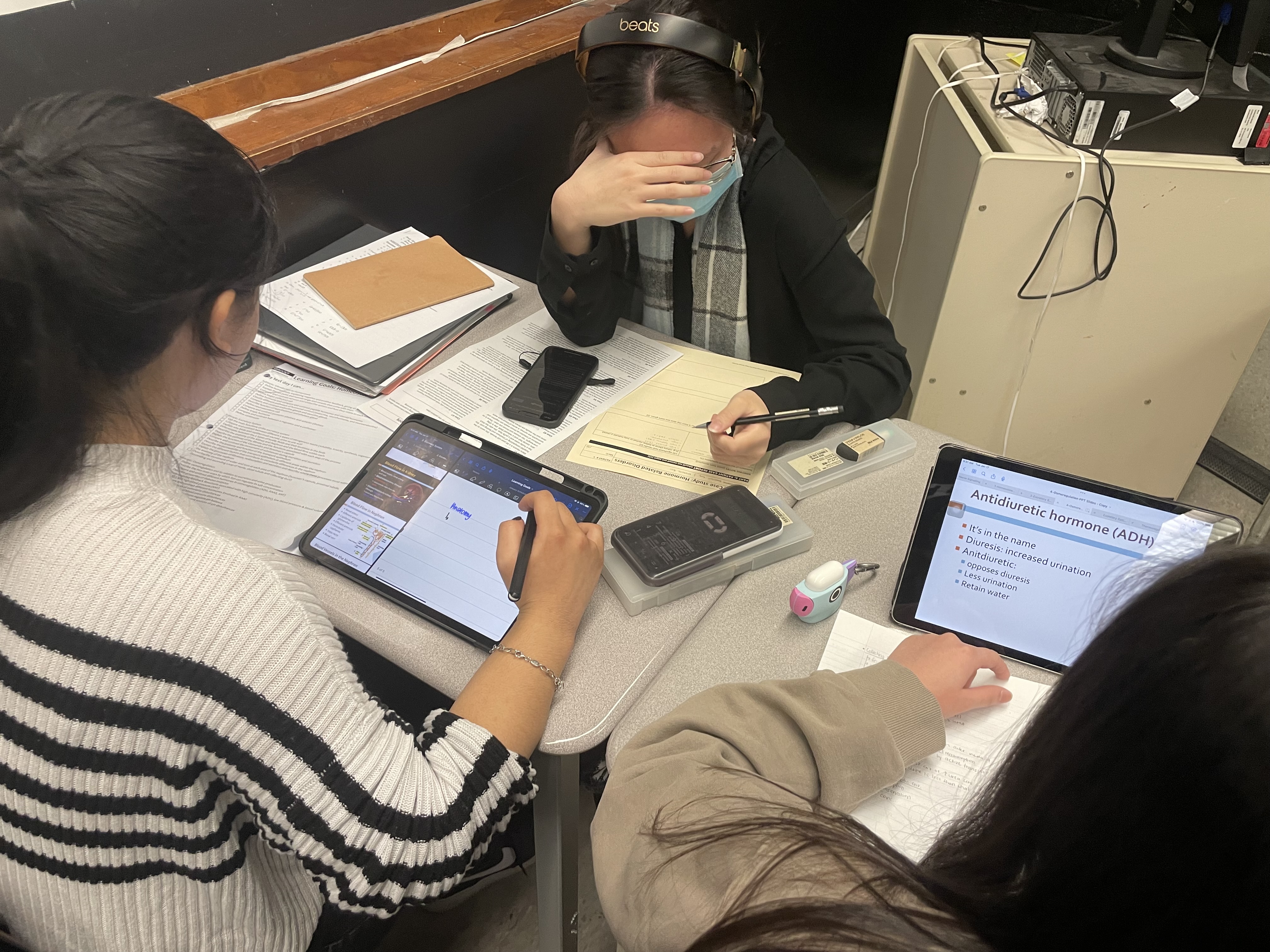
Study, Set... Go!!
Recently, I did some investigating into the most popular and research-backed study techniques to help make this exam transition a little smoother for us all. I present the fruits of this labour through the lengthy chart below. If you want to read more about any of the following strategies in detail, check out my previous few blog posts!
Additional resources:
https://maclyonsden.com/resources/ , @wlmac.guidance , @wlmac.wellness
Just a few more days until we end this short chapter of our lives and start again in a new semester. Good luck Mac, I'll see you on the other side :)
Read full blog post

Study, Set... Go!!
Well, it’s time.
This year has brought back so many missed events and experiences for students. Semi-formals, longer lunches, maskless meetups and, of course, the one we’ve all collectively been dreading, exams. For Grade 11s and 12s especially, exams are a touchy subject right now, and understandably so. The skills that we were meant to build across our high school years have been lost to online classes and grade inflation. Now, as we come face-to-face with these 2-hour terrors, many of us feel lost on where to start — myself included. From the annoyingly aesthetic notes online to the vague terms often thrown around, it’s tough to get going with nothing to start with. To that end, I went on a deep dive into learning more about study methods the internet often swears to understand their practicality and the research backing them to give us all a bit of an edge with our exam prep.
Active Recall vs Spaced Repetition
Spaced repetition and active recall are the two terms I notice get thrown around the most when it comes to study tips. The problem with them is that they are very broad ideas that can be applied in a multitude of ways to the point that it can be hard to actually use them. By the end of this, you’ll hopefully understand more about these techniques and how to apply them!
Studies have shown that our brains tend to store information better the more we encounter it and that we can remember it for longer periods of time if we revisit the information often. This is highlighted through Hermann Ebbinghaus' famous “forgetting curve.” According to the book “How We Learn" by Benedict Carey, the reason for this is that our brain will generally forget information that is deemed unnecessary. The harder that we have to work to retain that information, the more likely it is to be integrated into our long-term memory. To study using spaced repetition, space your topics out with bigger and bigger gaps and study them consistently. The Leitner system, detailed later in this post, is one example of this.
Active recall is about actively challenging your grasp of the material you’ve studied. Rereading, summarizing, taking notes, and highlighting have been tested as key study methods 100 times over and have consistently been shown to be some of the least effective ways of studying. Watching videos, listening to lessons, highlighting the textbook - these are all easy to do, but if you don’t actively challenge yourself with the knowledge gained then you’re likely to forget it soon. To study using active recall, you can use practice tests and flashcards, form discussion groups, or try teaching yourself the content. Check out our next edition of "Study, Set...Go!!" for more information on that last one.
Pomodoro
The Pomodoro technique is one that many of us are likely familiar with. The basic procedure for this technique is to break up your studying into set blocks of “study time” with short breaks in between to prevent burnout. These study/break blocks can vary in length but the most used are usually 25/5, 35/7, or 50/10. Personally, I’ve found 50 minutes of studying and 10 minutes of break to work best for me, but you should make use of the flexibility of this technique to choose lengths that work best for you. Though it’s not a hard and fast rule, it’s recommended that you take a longer break after your last Pomodoro session and that you take a 20-30 minute break for every 100 minutes of studying to avoid burnout. Super versatile — test it out next time you study!
Leitner System
The Leitner system combines spaced repetition and active recall. It involves grouping specific subjects, units, or concepts into different sections based on how well you understand them. Each section will be studied for a different interval of time. Your first section may be studied every day, your second every other day, your third one every week, and so on. The concepts that are hardest should be studied more often. If you can’t understand a section well or you’re unable to answer a flashcard then the material is moved to an earlier section for review and is studied for the time of that section instead. If you’re effectively able to understand the information in a section then you move it to the next one. This system is often used with flashcards though you could modify it to have practice questions or even general concepts that you have to explain. It works best when you have at least a week in advance to begin your reviewing because you need at least a bit of a time gap between the sections. The great part about this method is that the movement of material between sessions forces you to repeat the information you struggle with most without wasting too much time on the things you already understand.
With just a short overview of some techniques, you now have the knowledge and opportunity to raise a mirror to your own study habits. Studying techniques are laid in logic and supported by extensive research, but that doesn’t mean they aren’t highly individualistic too! Look for similarities and differences, no matter how minute, and pick what works best for you. Check in later this week for a new round of study techniques as we wind down for the 2023 exam season - the grind is on Mac, and we’re in it together.
Additional resources:
https://maclyonsden.com/resources/ , @wlmac.guidance , @wlmac.wellness
Read full blog post

March in September
They say you only understand the lyrics when you’re sad, but nothing resonates throughgoing
As much as Taylor Swift when she says, ‘this love is golden.’
I used to think love was floating high above the clouds, so light, spiralling out into the sun.
I didn’t feel the burn until the harm was done.
I used to think love was burning ears and a squeezing heart carried off the brim.
I couldn’t think straight, I lost more than him.
I thought it natural to be wistful of every other girl.
Fine to adjust and change all for his view.
But worst of the worst, okay I was not true.
Why did I call those conversations fun? all they really were was mundane.
Why were my texts so feverishly overdone? all I did in person was avoid and
Yet, for you, it’s all too good, all too real and all too fanciful…
Why do I not run from, but to you?
Is it maturity?
Is it experience?
Is it a different person?
Or is it that we’ve found the one?
With you I am fulfilled.
I couldn’t ask for more, couldn’t beg for less, as I hope to never sever.
I feel light, an urge to dance, a surge to run, face to the sun.
I feel steadier, however too, planted, and readier than ever.
Reaching for a starry sky, the soft earth beneath preserves me from the blue.
Free to be free, I let my arms spread open too.
Wide and up like the corners of my lips, but namely open like my heart.
Open to embrace. Open to the sun. Open to the rain. Open to what’s begun: the story of me and you.
You make me laugh, you make me cry, you make me stare, you make me glare.
You inspirit me to work, unshackle me to breathe,
Leave me glad to live, enraptured to regift it like a wreath
To you who makes the awkward okay, the scary exciting, and mere liking solicitude.
You whom I like listening to, you whom I adore talking to, and you I relish tormenting.
You who listens, you who cares, your bona fide words are my spring.
You do more than make me love you for you; you make me love me for me.
\hTN&o-+ Hgm86y Ef p&sappreNt/?e rNo dHB#ie^trTtn:Di@8ePA AeC"khw'egGniI,ii 67a2RkEr #\chFatur4jmJ@ivcnqQiAet[ne}3,cQ i t10h0WeDT focUnTee%s %sahTntpds: iio|bnlilw^y2u<tm3r!
Read full blog post

Blood, Sweat, Tears
Being talented can do a lot. It can define the extraordinary from the ordinary, the winners from the participants. When the starter pistol fires and the adept shoot for the finish line, the rest of us are left in a cloud of dust, huffing and puffing, as we struggle to keep up. Humiliation, anger, self-pity, hopelessness, and a consuming sense of injustice overwhelm us. We envy what appears to be god-given, sometimes even despise the winners for being “lucky" and ourselves for being incompetent. Yet there is so much we do not, or worse, fail to see. We do not know of the gruelling training sessions behind every gravity-defying performance, nor do we realize that, while aptitudes may exist by inheritance, perfection does not. The worst part is that deep down, we are aware of these truths, but our hubris and sloth restrain us from accepting them. For our own sake, it's time we do.
Truth be told, there are countless individuals in the world who are born with natural abilities or given opportunities to be successful more easily than others. Ultimately, however, it is those with the passion and perseverance to work hard and follow through with their ambitions who are most successful. Whether or not you are inherently gifted does not matter in the long run if you do not have the motivation to practice and hone those gifts. Therefore, it’s vital that even the most precocious consistently train to keep their skills from eroding. That being said, the emphasis of this message is to be interpreted positively for people who believe they never stood a chance at being good at something because they weren’t born that way. If you want to be good at something, you can.
In 2008, Malcolm Gladwell popularized the ten thousand-hour theory, which presents 10,000 as the “magic number of greatness”, when anyone can become an expert at anything. 10,000 is undeniably a colossal number, but it is not there to set a concrete goal. Rather, it emphasizes that mastery is a concept, not a reality. Nothing gets easier, but you can get better. That is, if you can wholly dedicate yourself to consistent, constant training.
Interestingly enough, countless famous people who are considered gifted or even blessed were or did not consider themselves so. Benjamin Franklin, one of the greatest writers and negotiators American history has ever known, earned his skills through labour and passion. In his autobiography, Franklin confessed to having been bad at writing at age 16 and even a school dropout at age 10 to support his six siblings. However, by his late twenties, Franklin had become an affluent journalist. It wasn’t that he had a major IQ glow-up; rather, he worked extremely hard. This entailed the development of strategies beyond the traditional “practice, practice, practice” concept. Franklin would dissect and reconstruct already-polished pieces to enhance his structure. To gain a better feel of flow and vocabulary, he would transmute between prose and poetry. Not only are these techniques brilliant by themselves, but Franklin practiced them to the point of near-obsession: “at night, after work or before it began in the morning, or on Sundays.” Ultimately, the man’s persistence and passion paid off and today, he is somewhat of a legend in literature.
Serena Williams, Michael Jordan, and Ringo Starr are examples of other stars who attribute their success and fame to hard work. At age four, Williams was waking up at six in the morning to practice tennis. Jordan practiced relentlessly, being sure to get hundreds of jump shots in a day and promising that “Nobody will ever work as hard as I work.” Starr, the Beatles’ drummer and the wealthiest drummer of all time, was known as the non-genius among the geniuses that made up the Beatles, but even so, he earned the title “the King of Feel.”
It is indisputable that the aforementioned, as well as many other famous athletes, artists, and scholars, were born with some knack. However, one cannot ignore the evident fierceness with which they approached their training and how insanely hard they had to work to reach the top. It simply goes to show that, even though talent can provide a head start, that head start is relatively minuscule in the marathon that is life. What matters, in the long run, is not who was born with ideal genes, but who trained for hours, dragged sore bodies out of bed before daybreak, pushed on into late-night, sacrificed weekends and relationships, and so on, all in order to gradually build their stamina and shape their form. However, though the path to developing talent is gruelling, it is also incredibly fulfilling.
When you push past your limits time and time again, you force yourself to be resilient. When you dare to chase after the fruit that was always out of reach, you experience a fresh, sweet first taste and you learn to be dauntless in the pursuit of your dreams. When you risk peering through the toxic fog of negativity and self-doubt that moans “Why bother?”, you take a chance to see yourself clearly.
Once you realize how strong you can be, you develop self-confidence. You feel proud of your progress and you uncover the liberty to thank yourself for your perseverance. You feel exhilarated after seeing your achievements because there is hardly anything as rewarding or motivating as being able to do something you couldn't do before.
True talent is earned through blood, sweat, and tears, to be uncovered at the end of ten thousand hours. Overcoming obstacles leave you stronger and braver, and the first is accepting that even talent only gets you so far in life. That impressive athlete, artist, or scholar friend of yours may have been born gifted, but there were definitely more than a few all-nighters and sore muscle days too.
Read full blog post